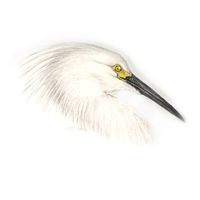|
Field
Guide IDs: BREEDING:
Marshes, lakes,
ponds, shallow coastal habitats. 1 brood DISPLAYS:
With erect plumes:
territorial display incl crest raising, accompanied
by calls; in courtship: male stretches neck, points
bill skyward and calls; circle flight, tumbling
flights. NEST:
Rarely in cactus or
on ground; flat, flimsy, of sticks. Lined with fine
twigs, rushes. Occ in marsh vegetation. Male
collects material, female builds. EGGS:
Light bluish-green.
1.7" (43 mm). DIET:
Also small
vertebrates. CONSERVATION:
Winters s to n S.A.
Decimated by plume hunters; subsequent range
expansion beyond prehunting limits. DDE (probably
from Mexico) leads to nest failure in ID
populations. NOTES:
Highly colonial,
usu in mixed colonies. Asynchronous hatching often
leads to starvation of smallest chicks. Young leave
nest at 20-25 days. Most diverse foraging
techniques of any heron; active pursuit of prey
compared with most herons, egrets. Uses yellow feet
to stir mud to flush prey. Occ feeds following
Glossy Ibis (or other species) and capturing food
stirred up by ibis. Communal roost at night when
not breeding, oft moving to and from roost in
flocks. Irregular visitor
to Lagunita in winter and spring, when water is
present. ESSAYS: Plume
Trade;
DDT
and Birds;
Communal
Roosting;
Commensal
Feeding;
Brood
Reduction;
Range
Expansion. REFERENCES:
Erwin, 1983;
Hancock and Kushlan, 1984; Raye and Burger,
1979. |
